By Jeffrey A. Rendall; Photos By Jeff Janas
MYERSVILLE, MD -- 'Every new beginning is some other beginning's end,' crooned the pop lyrical philosopher, when recounting the birth and eventual death of barroom inspired romantic affairs.
Though hardly fostered at the spur of the moment (or in a barroom), some might say a very similar thought applies to Musket Ridge Golf Club in Myersville, Maryland (which opened in September of 2001), since it was the final work of noted golf architect Joe Lee, who passed away in April of 2003 after being ill for quite some time.
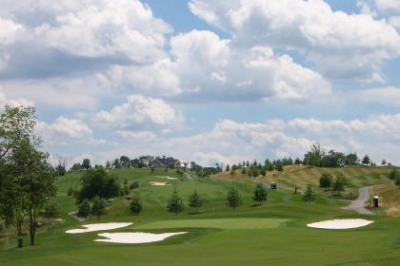 |
| Looking towards the Blue Nine's 8th green. This 215 yard par three will play quite difficult when into the wind. |
Therefore, Musket Ridge's beginning was ironically the ending note on a magnificent course architectural career. Lee's probably best known for dreaming up such notable golf layouts as Cog Hill in Chicago, Bay Hill and Doral (Blue Monster) in Florida and Torrey Pines in San Diego (all of which have hosted PGA Tour events and have since undergone upgrades by other architects). But he'll also certainly be remembered in this part of the country for his swansong golf layout just west of Frederick.
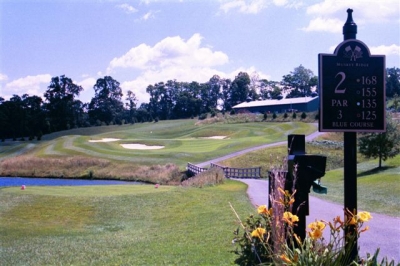 |
| The Blue Nine's 2nd hole is one of the few that requires a true carry -- though at 168 yards (from the back tees), it won't scare many people. |
Fellow golf architect Tim Freeland worked with Lee on the Musket Ridge project, and describes their collaboration: "One of Musket Ridge's owners (David Taylor) was a member with Joe Lee at Turtle Creek down in Jupiter, Florida -- Lee had designed the club's course, and Mr. Taylor obviously thought highly of it. Taylor asked Lee if he'd consider designing a layout up in central Maryland, and that's how the project started."
Freeland (who served as Gary Player's senior architect for many years) continues, "Joe's health declined as the work went on, and Taylor contacted me about becoming the project manager for the golf course, under Lee's direction. As time passed with the project, more and more design changes needed to be made, and my relationship with Joe Lee strengthened to the point where he had complete confidence in me to make decisions regarding architecture in the field, when he wasn't able to travel up there."
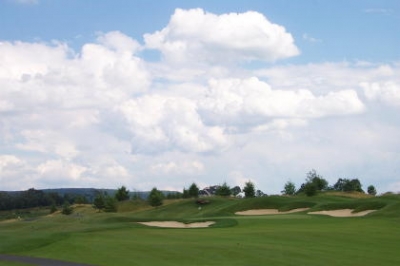 |
| The Ridge Nine's 401 yard, par four 5th hole (#14 on the back nine) presents a well-bunkered green. |
"We communicated constantly via photographs and discussions, and all in all, he gave me quite a lot of freedom to perform design work on that project. I'd basically anticipated being more of a construction coordinator at Musket Ridge -- but he enjoyed our working relationship and taught me so much about how to do things, that I felt I could work the course in ways he would appreciate and approve of. The fact it was Joe's final golf design will always place Musket Ridge as a special memory in my mind," Freeland said.
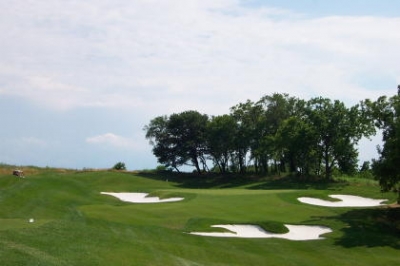 |
| Tim Freeland said the par three 17th (Ridge Nine's 8th) hole was a good example of how Joe Lee liked to build bunkers at different elevations. |
The selection of Lee to design Musket Ridge on this historic piece of land was as natural as tabbing Norm from 'Cheers' to work on a beer-tasting job in Boston. Lee was a direct descendant of General Robert E. Lee, who helped make this part of Maryland famous when marching his troops through the area in September of 1862 (during the Civil War's Antietam campaign). Joe Lee often noted his ancestral past's connection to this land, and treated the ground with added reverence and respect.
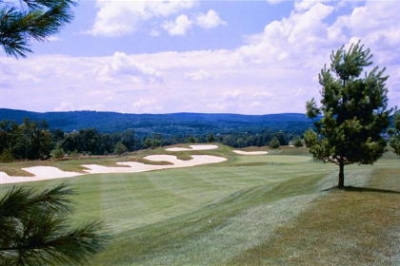 |
| The par five 10th hole (Ridge #1) features a mammoth bunker down the left side of the lay-up landing area. |
The loving care certainly shows. Musket Ridge joins several other upscale courses in the Frederick area, making this growing Washingtonian suburb one of the richest public golf regions in the Mid-Atlantic.
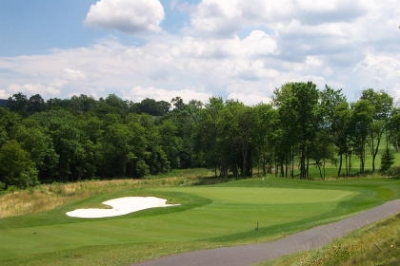 |
| The 448 yard, par four 7th hole (Blue Nine) offers a wide run-up option. |
But it's not like this course will get lost in the crowd. According to David Freiss, Head Golf Professional at Musket Ridge, the club has a character all its own: "The views up here are absolutely spectacular. I don't know of another golf course in the Baltimore/Washington area, within 45 minutes of both beltways, where you'll get the same feeling that you're hundreds of miles away."
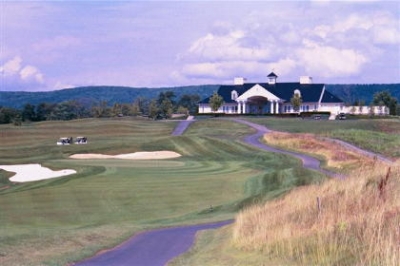 |
| A fine finish to a golf round at Musket Ridge. The clubhouse overlooks the 18th green, with beautiful scenery all around. |
"More than just pretty scenery, we've gotten hundreds of compliments on the golf course. The design makes it playable and enjoyable for higher handicappers, because of the wide fairways and approachable greens. But if you stretch it to the back tees, it'll also challenge lower handicappers and golf pros. For that reason, I definitely think it's one of the premier courses in the region," Freiss said proudly.
Pardon the expression, but Friess is not just whistling Dixie. Without question, Musket Ridge belongs high up on the list of the best facilities in the reachable Washington area. I can honestly say, I've never heard a negative comment about it.
Lee himself spoke glowingly of the property's natural attributes, but according to Freeland, it was the elder statesman's knack for framing golf holes that transformed an already beautiful landscape into a spectacular golf course: "Joe Lee was a master at framing a golf hole with fairway bunkers. He used substantial earthwork in his fairway bunkers, which really elevates them and pitches the sand back towards the player. As a result, the sand serves as a directional road sign, and there're never any surprises."
"One thing I'll take from our collaboration was Lee's desire to place bunkers at different elevations on a golf hole. Musket Ridge's 17th hole is a good example -- it's a short par three, but you'll get quite a grasp on the depth of the hole by the placement of the sand," Freeland added.
Lee's focus on visibility and fairness adds another characteristic to his work. Again, Freeland expounds: "You see the sand and the putting surfaces very well at Musket Ridge, and there're no tricks in Lee's designs. A lot of golf architects these days are falling into the trap -- worrying so much about equipment technology and players shooting lower scores -- that we've gone overboard in making golf course designs overly difficult."
"Well, Lee didn't do that. Joe Lee thought that if you're able to hit the ball long and straight, that you should be able to score well. He also kept the putting surfaces relatively flat in terms of undulation -- if you're good enough to get there in regulation, you should have a shot at making a birdie. It's a simple philosophy, and it works."
It does work, but all of the praise for Musket Ridge doesn't mean it's perfect. The conditioning of the course was excellent, yet we found the bunker sand around the greens to be somewhat difficult to blast out of. Freiss said the situation's being rectified: "We're in the process of replacing some sand -- it wasn't of the quality that we wanted. It was too firm for greenside bunkers, but perfect for fairway bunkers."
And though the course is certainly generous to the hackers off the tee, there's also a lot of tall grass waiting should you miss the playable areas. Ben Hogan used to say -- if you hit one out-of-bounds, you deserve the two-stroke penalty. But the courses these days seem to enforce the concept a bit more stringently than days of old.
Musket Ridge continues the trend.
Freiss elaborates: "I'd say the most difficult aspect of our layout is getting through eighteen holes without hitting it into the native fescues that line most of the fairways. The golf course provides plenty of room off the tee, but if you stray a little bit, you'll get in deep and possibly in trouble."
"The wind's also a factor. Because we're up on the ridge, the breezes make the playing conditions more difficult, especially if you have a crosswind. This course may look like a pussycat, but it's more like a tiger if the weather's a bit off," Freiss surmised.
The day we played just happened to be one of those days. While the sun was shining brilliantly, the prevailing wind made several of the course's most difficult holes that much harder. The final three holes on the front nine measure 448 yards (par four), 215 yards (par three) and 567 yards (par five) respectively. All played into the wind, and par's an excellent score on any of these holes under those conditions.
But in general, reaching par on most holes is certainly an obtainable goal. Again, Freiss speaks: "If you can keep the ball in play off the tee here, you can score. There are no forced carries, and most of the trouble's either way left or way right. Very seldom is it in front of you, and you can roll the ball up on your approaches to the greens."
"We get a lot of comments from people saying they've shot their best score here, which we love to hear, because that means they've been able to keep the ball in play off the tee," Freiss said.
"But again, if you play from the tips, the landing areas tend to narrow as you near the green. So the better player, the longer hitter, needs to be a little more precise. The greens also have just enough undulation, so if we host an event where we'll need the golf course to play a little more difficult, we can tuck the pins."
Sounds like the complete package. Highlights on the front nine include the sixth hole, often considered Musket Ridge's signature link. The scenic view from the tee is simply spectacular, with a 360-degree panorama of majestic mountains and valleys.
The golf hole isn't bad either. Playing 520 yards from the back tee, you're driving to a dogleg left that's just begging players to try and cut the corner. If you hit it long, you'll have a very intriguing choice on whether to go at the green in two. Freiss describes the green's shape as 'extremely unique,' which is pretty accurate, since it's fairly long and pretty narrow. Risk-reward all the way if you're trying to make birdie here.
On the back nine, the 16th hole is an interesting par four. 413 yards in length, you're shooting from an elevated tee to a fairway split by a ridge. Keep it down the left side, because a shot with left to right motion will certainly move downhill towards a hazard and environmentally sensitive area. For the approach, there's a view towards a fairly long green sloping severely from back to front. One piece of advice: stay below the hole.
Finishing up, you'll see the clubhouse perched attractively overlooking the course. During the warm weather months, I'd certainly recommend catching a quick burger in between nines or after the round -- cooked right there on the patio grill.
The view from the clubhouse deck is certainly inspiring. Musket Ridge is a fitting final tribute to Joe Lee's devoted profession, one that I'm sure he was happy to call the swansong of his life's work.
Details:
Musket Ridge Golf Club
3555 Brethren Church Rd.
Myersville, MD 21773
Phone: (301) 293-9930
FAX: (301) 293-9591
Website: www.musketridge.com
Course Architect: Joe Lee
Lee's Project Manager: Tim Freeland
Head Golf Professional: David Freiss, PGA
Superintendent: Doug Witcraft
|
Tees |
Yardage /Slope |
Rating |
|
Gold |
6902/140 |
73.0 |
|
Mon./Tuck. |
6416/130 |
71.1 |
|
Sham./Tuck. |
5884/123 |
68.9 |
|
Red |
5333/124 |
71.1 |
Rates:
Consult the website for current rates.
Call the club for off-season rates; there's also a Player's Club for frequent players.
Rate includes greens fee, golf cart, complimentary use of the practice range, but does not include state & local taxes.
| Related Links | Comments on this article? | |
|
Maryland National Golf Club Hollow Creek Golf Club Rocky Gap Resort PB Dye Golf Club in Ijamsville Whiskey Creek Golf Club |
E-mail Jeff Rendall, Editor: jrendall@golftheunitedstates.com |












